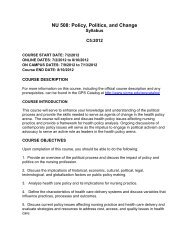SAINT JOSEPH'S COLLEGE DEPARTMENT OF NURSING
SAINT JOSEPH'S COLLEGE DEPARTMENT OF NURSING
SAINT JOSEPH'S COLLEGE DEPARTMENT OF NURSING
You also want an ePaper? Increase the reach of your titles
YUMPU automatically turns print PDFs into web optimized ePapers that Google loves.
NU 420 Clinical 2012 9INTRAVENOUS THERAPY POLICYPOLICY FOR INSERTING A PERIPHERAL-SHORT OVER-THE-NEEDLE CATHETERPOLICY – Students must follow the agency policy and procedure regarding I.V. insertion. After meeting the agencyrequirements, this policy applies to all SJC nursing students who have successfully completed the IV insertion labCannulas are placed for definitive therapeutic and/or diagnostic indications. The smallest gauge, shortest length cannulacapable of accomplishing the prescribed therapy shall be used. The supervising R.N. and hospital policy will determine adultpatient selection. The student will be limited to two attempts per patient, if the patient is willing.Based on standards of the Infusion Nurses Society (INS), the placement of catheters shall be in accordance with the stateNurse Practice Act. The catheter selected shall be the smallest gauge and shortest length that will accommodate theprescribed therapy. Aseptic technique shall be used and standard precautions observed during catheter placement. Only onecatheter shall be used for each cannulation attempt (Phillips, 2010, Manual of I.V. Therapeutics).*****************************COMPETENCY CRITERIA: Initiation of Peripheral I.V. Therapy following the Phillips Steps. (Phillips, 2010, Manual of I.V.Therapeutics)COMPETENCY STATEMENT: Competent I.V. nurses will be able to perform venipuncture technique for support of peripheralI.V. therapy.NOTE: The cognitive (knowledge) information that is embedded within this performance-based competency includes aseptictechnique, manufacturer recommendation for use of equipment, venous anatomy and physiology, fluid and electrolytebalance. This competency links to the competency of infection control, management of I.V. equipment, and parenteralsolutions.CRITICAL ACTION STEPSEquipment NeededIV start kit (if available)Clean glovesIV catheter (size/gauge dependent on need)Prep solution (chlorhexidine gluconate recommended)Non latex tourniquetTransparent semipermeable membrane (TSM) dressingLocking device with needleless valve (T connector/clave primed with sodium chloride flush syringe) and if appropriate IVinfusion set-upLocal anesthetic (Based on authorized prescriber’s order)Pre Cannula Insertion1. Verifies authorized prescriber’s order.2. Uses proper hand hygiene through the use of either a waterless, alcohol-based hand rub product or an antimicrobialsoap and water hand washing for 20 sec with adequate rinsing (CDC Guideline).3. Gathers equipment, performs an inspection of I.V. equipment to ensure product integrity, and prepares equipment. (e.g.T connector primed with an attached normal saline flush)4. Introduces self to the patient.5. Checks patient ID using two patient identifiers (Checks ID bracelet and asks patient to state name. (Joint Commission SafetyGoal)6. Provides privacy. Explains procedure and gains the patient’s verbal consent. Also, interviews the patient regarding previous
















